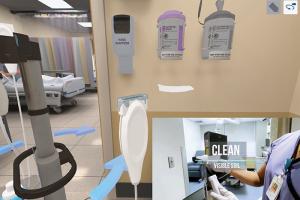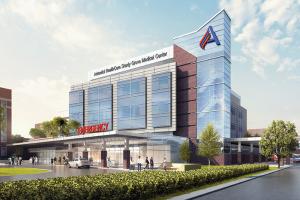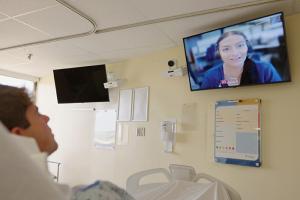Reimagining hospital facilities operations

The pressure to reduce expenses presents an opportunity for facilities leaders to become stars in organizational stewardship.
Image by Getty Images
Facilities leaders are consistently being asked to do more with less, often impacting the workforce, making human resource management a core aspect of a facilities leader’s daily challenges.
Health care organizations expect their buildings to run seamlessly behind the scenes, but the wizards behind the curtain are the facilities leaders coordinating everything from regulatory compliance and optimal building systems operations to energy efficiency and maintaining a continuous talent pipeline to ensure safety.
According to the Bureau of Labor Statistics, the general maintenance; engineering; electrical; and heating, ventilating and air-conditioning (HVAC) workforce will grow by an average of 4% to 9% over the next eight years. While much of the labor force is local and state influenced, facilities leaders know that health care is a niche of these job categories, and labor shortages will continue to create challenges within health care facilities departments.
In today’s rapidly evolving health care environment, stewardship is the foundational framework of operational excellence and workforce engagement. By incorporating and integrating non-conventional stewardship techniques, facilities leaders have the opportunity to drive transformative change and enhance the workforce.
Role of facilities operations
As reimbursement for health care declines, the pressure to reduce operating expenses, labor and supplies often is the trade-off. This presents an opportunity for facilities leaders to become stars in organizational stewardship. Because facilities operations often is viewed as an expense, it is the facilities leaders’ role to demonstrate how proactive management of resources reduces waste while positively impacting the environment, patients and staff within the buildings.
In this context, addressing labor and material costs, enhancing team collaboration and improving efficiency are essential goals.
Just as environmental stewardship transformed operations in the early 2000s, today’s facilities leaders are turning to digital tools to take the next step forward. Sustainability became a driving force as rising energy costs and growing environmental concerns prompted action. This focus was further supported by the availability of green building technologies, allowing health care facilities to adopt sustainable practices without compromising quality or cost-effectiveness.
As health care organizations continue to face staffing shortages and increasing demands for services, there is growing recognition that investing in technology can support the current and future workforce. By leveraging new technologies for daily activities, building optimization and workforce development, health care facilities leaders can achieve the concept of doing more with less. Just as environmental stewardship has reduced costs, technology-driven stewardship can enhance operational efficiency.
Often, the optimization of facilities operations is manual and labor intensive, with cumbersome processes involving regular inspections, data collection and reactive maintenance. However, the introduction of advanced technologies like the Internet of Things (IoT) and artificial intelligence (AI) has revolutionized how health care facilities can manage their operations, enabling real-time monitoring and data-driven decision-making.
IoT refers to a network of interconnected devices and sensors that collect and share data in real time. In health care settings, these sensors can be deployed across building equipment and integrated into building automation to monitor critical systems like lighting, HVAC, water and equipment.
For instance, IoT sensors can track energy consumption across different zones in a facility. If an area is consuming more energy than expected, perhaps due to malfunctioning equipment or inefficient systems, the system can automatically flag the issue and alert the facilities team. On the flip side, IoT proactively can optimize areas by turning off lights or adjusting temperatures in underutilized areas based on occupancy patterns.
Both examples of alerts and setting adjustments can be utilized for staff to address problems before they escalate, reducing energy waste and extending the lifespan of equipment. Although IoT can be implemented incrementally, some upgrades may be necessary to utilize or optimize, depending on the age of the equipment.
While IoT gathers real-time data and alerts to singular issues, AI takes this a step further by analyzing it and making intelligent decisions. Systems that are layered with the power of AI can predict future demands based on historical patterns and adjust building systems accordingly. For example, AI can anticipate increased energy usage during certain times of the day, such as when more patients or staff are present, and adjust lighting systems in advance. AI also can identify trends, such as seasonal energy spikes, allowing facilities to proactively plan for these increases and optimize energy use.
In addition, AI can work in tandem with IoT systems to automate real-time adjustments. For instance, AI can modify the temperatures that were identified due to the seasonality or occupancy. These automatic adjustments reduce the need for constant staff intervention, ensuring continuous optimization of various operational aspects.
IoT and AI benefits
Integrating IoT and AI not only optimizes facilities management operations but also can boost workforce productivity, improve safety and reduce manual tasks. These technologies empower health care facilities staff to be more efficient and effective, allowing them to focus on high-value tasks, potentially increasing job satisfaction and engagement. By identifying peak workloads, system usage and maintenance trends, leaders can better plan for future hiring needs, skill gaps and workforce succession. Some of these benefits include:
- Reducing time spent on routine tasks. Facilities managers and maintenance teams often spend a significant amount of time on routine inspections and documentation of relevant information. With the addition of technological features on equipment, facilities teams can be alerted only when issues arise, saving time. For example, in the case of a malfunctioning HVAC system, AI can automatically notify the building automation system and the maintenance team, eliminating routine manual inspections and building rounds. This saves time and allows staff to prioritize maintenance activities and work order responses. It also has the potential to reduce staff fatigue from mundane and repetitive work. Like clinical staff with alarm fatigue, when facilities teams complete the same routine tasks over and over, there is a potential to miss an underlying issue. Leveraging technology for detection can significantly mitigate the risks associated with high-stakes failures.
- Empowering employees with real-time data. With access to the data through a computerized maintenance management system or other building maintenance program, staff can monitor system performance, identify potential issues and adjust directly from their mobile devices or tablets via a centralized dashboard. This data-driven autonomy empowers employees to act quickly and make decisions on-site without waiting for managerial approval. Whether it is adjusting the temperature in a room or scheduling maintenance for malfunctioning equipment, real-time data allows staff to optimize operations efficiently and alerts them to the potential problem.
- Improving worker safety. Beyond operational efficiency, IoT and AI also enhance workforce safety. IoT sensors monitor environmental factors like air quality, temperature and humidity to ensure conditions are safe for both staff and patients. For instance, if carbon dioxide levels rise above safe limits, sensors will trigger an alert, prompting staff to take corrective action. AI also helps monitor equipment for potential safety risks. By analyzing data on equipment performance, AI can predict when a system is likely to fail, allowing staff to address the issue, reducing risk to patients or staff.
- Upskilling the workforce. As technologies evolve, the workforce will need to adapt. Upskilling will be essential, and health care facilities can invest in training programs that teach employees how to interact with these technologies. From understanding how to interpret data to troubleshooting smart systems, training programs will ensure that employees remain skilled and confident in their roles. Leaders also should encourage continuous learning, providing opportunities for staff to gain new competencies in predictive maintenance, AI-driven optimization and other emerging technologies. By equipping employees with the skills to work alongside technologies, health care organizations can foster a more innovative, capable workforce.
Optimizing teams and leaders
Incoming generations of workers have been utilizing technology since a very early age and expect health care facilities and teams to be embracing innovation and technology. By integrating IoT and AI, health care facilities can position themselves as forward-thinking employers of choice. The opportunity to develop specialized skills for future career growth also is appealing to incoming workers. Additionally, it allows for the creation of mentoring opportunities that enable teams to collaborate to solve problems. As a field that prides itself on being optimal problem solvers, this is another tool in the toolbox.
However, not all workers entering the health care facilities field will be looking at technology as a career path, and with dwindling options for skills training, leaders also can look to adapt and enhance traditional training styles. Health care facilities require a highly skilled workforce to maintain a range of systems, such as HVAC, electrical systems and plumbing, while ensuring that the environment is safe, efficient and comfortable for patients and staff.
One innovative technology that can be utilized is virtual reality (VR). Various platforms offer health care facilities the ability to train their teams in a realistic, virtual environment without the risks or costs associated with traditional training methods. VR provides immersive simulations that replicate real-world scenarios, allowing trainees to practice and refine their skills in a controlled environment. Studies show that VR-based training can improve knowledge retention compared to traditional methods and can support safety by ensuring that teams are competent prior to taking on new tasks and assignments.
By integrating new strategies, health care facilities leaders can effectively train incoming talent, ensuring they are equipped to maintain critical systems and provide a safe, efficient and comfortable environment for patients and staff. These strategies also have the potential to empower employees, fostering engagement and retention. When employees feel autonomous and see the positive impact of their work, they experience intrinsic satisfaction, which perpetuates continuous learning, adaptation and the sustainability of best practices. This, in turn, results in improved employee retention and stewardship.
In fact, technological advancements are not just for optimizing teams but also for optimizing leaders. There is a significant amount of research discussing the rate of burnout in health care, much of which is attributed to repetitive tasks.
Embracing AI can support daily work such as creating schedules, planning employee engagement activities and generating forms for teams to fill out, thus reducing the time facilities leaders spend at their desks and creating more time for them to spend in the field, supporting the team.
AI also can support tasks that are less utilized. For example, AI can analyze data, forecast financial impacts and create a concise, data-driven proposal when building a financial business case to implement a new piece of equipment, technology or process. This reduces the time spent on manual calculations and enhances the accuracy of financial projections.
However, the adage “garbage in, garbage out” still applies. The quality of AI insights depends entirely on the quality of the data it’s given. Ensuring the input data aligns with the intended outcome, along with careful review to ensure the message is correct, will always be required.
Empowering facilities operations
The integration of IoT and AI has redefined health care facilities operations. By automating routine tasks, providing real-time insights and enabling predictive optimization, these technologies can enhance both efficiency and workforce stewardship. Future health care facilities workers will benefit from smarter decision-making, greater autonomy and continuous skill development, enabling employees to thrive in an increasingly data-driven world.
Although investment in these advanced technologies depends on the age of the facilities, the long-term benefits should be evaluated against initial costs. Efficient systems, coupled with IoT and AI-driven predictive maintenance, significantly reduce operational expenses, extend equipment life and optimize resource use.
By investing in both people and technology, health care facilities can unlock a future that is not only more efficient but also more human-centered, resilient and ready for whatever comes next.
Related article // Six considerations for integrating technology into facilities operations
Integrating technology into health care facilities operations offers numerous benefits, including optimizing building management along with workforce efficiency and stewardship. However, implementing these various tools involves factors that can influence their effectiveness. It’s essential for facilities leaders to reflect on the specific needs and priorities of health care facilities by examining the following six key considerations:
- Facility readiness. Facilities leaders can assess a facility’s readiness for technology integration by considering the following questions: Is the building management system capable of integrating with new technologies? Does the facility have reliable Wi-Fi or wired network infrastructure? Is the maintenance program reactive or predictive? How receptive is the team to technology integration? Does the facility have baseline energy usage and system performance data? What building systems frequently fail or are resource-intensive? How does the team currently track facility performance?
- Cost-benefit. Facilities leaders should conduct a detailed cost-benefit analysis to understand the long-term savings and efficiency gains. It should cover both the initial investment and ongoing maintenance and operational costs.
- Data security and privacy. Facilities leaders should work with information technology stakeholders to ensure that any new technology complies with relevant regulations (e.g., HIPAA and cybersecurity) to protect sensitive health care data. They should address data security and privacy concerns early in the planning process.
- Scalability. Facilities leaders should consider how vendor choices can scale with future changes. They should ensure that the preferred solutions can be expanded or adapted as needed.
- Workforce adaptation. Facilities leaders should analyze the current state of each team member’s job roles and accountabilities. They should determine how roles and tasks will change post-implementation and whether this will impact scheduling.
- Training and change management. Facilities leaders should assess how a comprehensive training program can ensure staff are comfortable with the new technology. They should review change management strategies to ease the transition and address any resistance.
By considering these factors, health care facilities leaders can begin the journey of integrating technology into their building systems, enhancing operations and supporting workforce stewardship.
Danielle Gathje, MBA, CHFM, SASHE, is vice president of hospital operations at Fairview Health Services | St. John’s Hospital in Maplewood, Minn. Her email is danielle.gathje@fairview.org.





